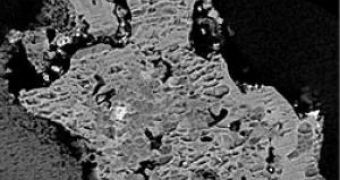The comet dust gathered from a comet in the Kuiper Belt by the Stardust mission has presented clues about the birth of our solar system which do not agree with the theories that the solar nebular is gently collapsing inward to form the sun and the planets.
Stardust spent most of its mission orbiting the Kuiper Belt, far beyond Neptune. The particles are the same material that accreted along with ice to shape the comet about 4.57 billion years ago, when the sun and planets formed.
The finding of osbornite, a mineral found on Earth only in Russia, captured the attention of the researchers. "We're talking about a mineral that forms around 3,000 degrees Kelvin, which means it formed close to the hot infant star," said John Bradley, director of the Laboratory's Institute for Geophysics and Planetary Physics and the head of the Livermore Stardust team. "If we found it in the comet, then how the heck did it get out there".
The international team formed by more than 200 researchers used state-of-the-art technology, SuperSTEM (scanning transmission electron microscope), enabling it to determine the make-up of the tiny particles at the angstrom scale.
The osbornite is an indicator that during its beginning, the solar system was a very volatile locale in which objects in the inner area may have been ejected in bipolar outflows perpendicular to the solar accretion disc and rained down into the outer regions. "It appears to have been a much more dynamic and perhaps even violent nebula environment than we expected," Bradley said.
In addition to outer solar system materials, the comet samples embarked outer solar system materials but also pre-solar materials that must have been transported beyond the orbit of Neptune by a process that was capable of moving particles at least as large as 20 microns.
The osbornite presence means that large particles could be launched by a type of wind from a region within a few radii of the young sun and transported above and below the midplane of the nebular disk, from near the sun to the edge of the solar system.
Particles larger than a micron are mostly silicate minerals like olivine and pyroxene, that also appear at very high temperatures. "It's shaking up our view of the solar system condensation process," said Hope Ishii, a Livermore Stardust researcher. "It's been pretty intense. It opens up a whole bunch of new questions."
Livermore researchers also used the Laboratory's secondary electron microscope, nanoSIMS and Focused Ion Beam (FIB) technology in their analyses. FIB detected craters containing minuscule particles in the collector foil. The foils contained the only examples found thus far of presolar material.
Stardust samples also contained organic materials dispersed around the impacts. "We didn't expect any organics to survive from the impact and heat during the collection process," said Livermore researcher Sasa Bajt. "But we found a rich variety of organics that were both oxygen-rich and nitrogen rich compared to organics previously found in meteorites."
Organic matters may point to how life originated on Earth. Stardust is the first spacecraft to safely return to Earth with cometary dust samples.
Photo Credits: Hope Ishii, Stewart Fallon, Ian Hutcheon, John Bradley. Osbornite on Comet Dust

 14 DAY TRIAL //
14 DAY TRIAL //